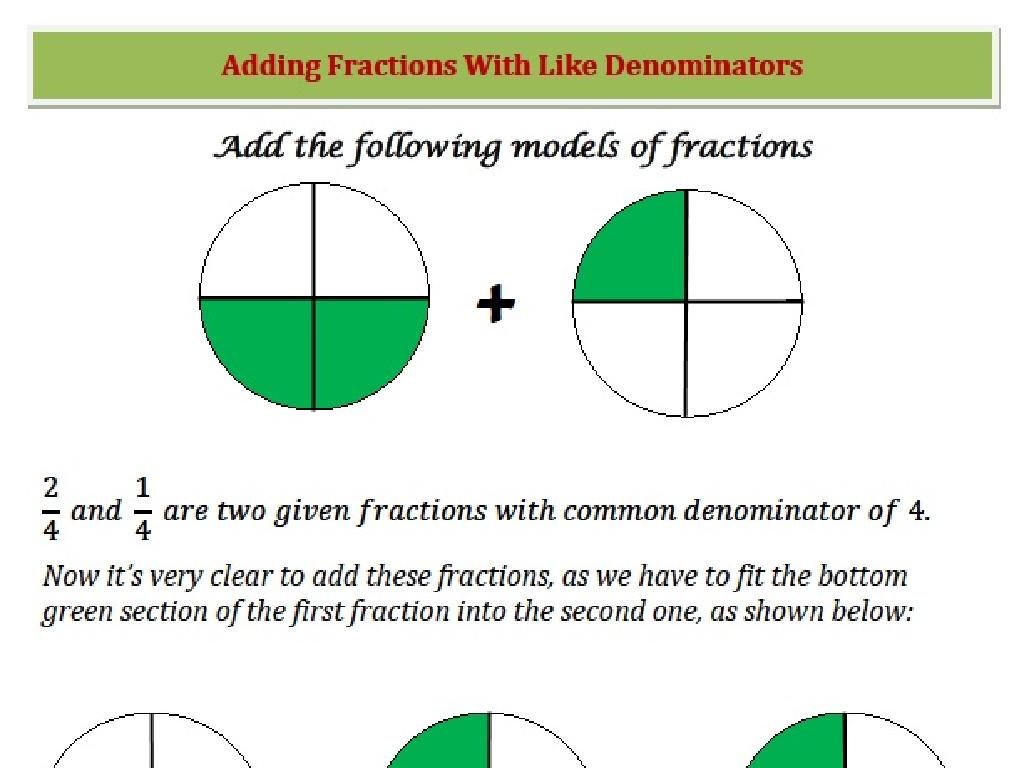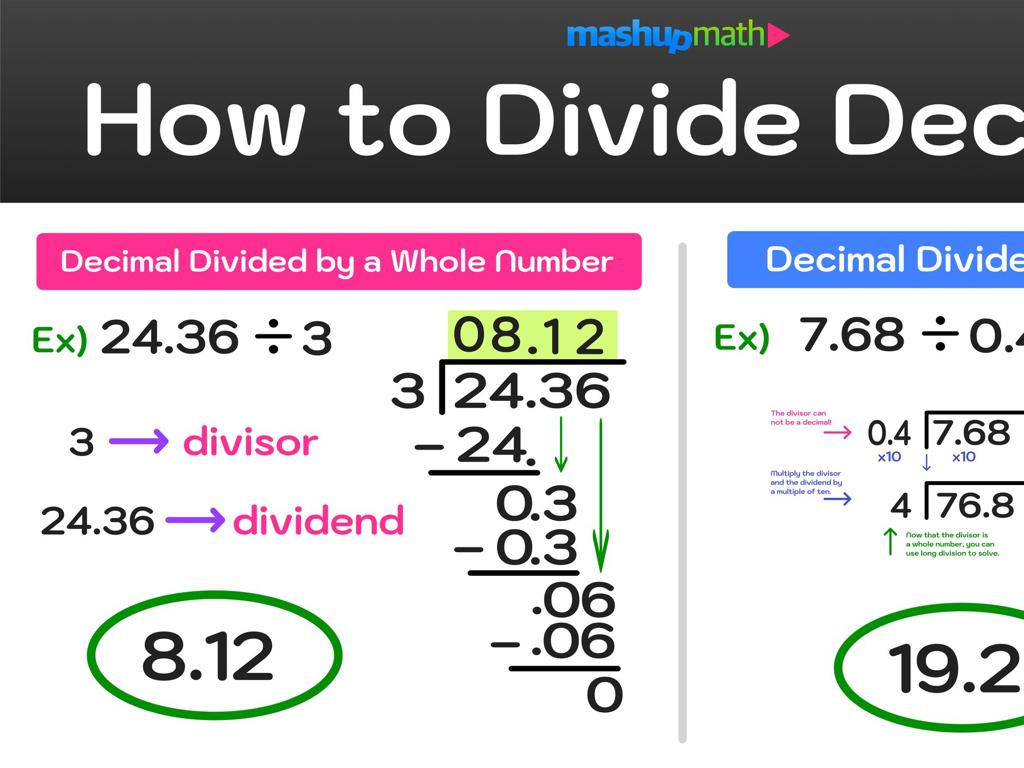Transformations And Similarity
Subject: Math
Grade: Eighth grade
Topic: Transformations And Congruence
Please LOG IN to download the presentation. Access is available to registered users only.
View More Content
Transformations and Similarity
– What are transformations?
– Movements that change the position of a shape without altering its size or shape.
– Types of transformations
– Translation (slide), rotation (turn), reflection (flip), and dilation (resize).
– Exploring similarity
– Figures are similar if they have the same shape but different sizes; proportional sides and equal angles.
– Similarity vs. Congruence
– Similar figures have equal angles, congruent figures have equal sides and angles.
|
This slide introduces the concept of transformations and how they relate to the similarity and congruence of figures. Transformations include translation, rotation, reflection, and dilation, each of which changes a figure’s position or size while preserving its shape. Similarity involves comparing shapes that have the same form but different dimensions, while congruence deals with identical size and shape. The learning objectives are to identify and perform these transformations and to understand the criteria for similarity in figures. Encourage students to visualize these concepts with hands-on activities, such as using graph paper to draw transformed shapes or identifying similar figures in the classroom.
Exploring Transformations in Geometry
– Defining geometric transformations
– A transformation moves or changes a figure in specific ways.
– Types: Translation, Rotation, Reflection, Dilation
– Translation: slides, Rotation: turns, Reflection: flips, Dilation: resizes.
– Transformations alter shape’s position/size
– Position changes: sliding, turning, flipping. Size changes: enlarging or shrinking.
– Similarity and changes in figures
– Similar figures have the same shape but different sizes due to transformations.
|
This slide introduces the concept of transformations in geometry, which are operations that alter the position or size of a shape. It’s crucial to explain each type of transformation: translation (sliding), rotation (turning), reflection (flipping), and dilation (resizing). Emphasize that these transformations can change the location and size of figures, leading to similar figures shapes that are the same but scaled differently. Use examples like moving a piece of paper, turning a key, looking in a mirror, and zooming in on a picture to illustrate each type. Encourage students to visualize and perform these transformations with physical objects or drawings to grasp the concepts better.
Exploring Similarity in Shapes
– Understanding shape similarity
– Similar shapes have the same form but can differ in size.
– Criteria for similarity
– Shapes are similar if they have the same angles and proportional sides.
– Exploring similarity transformations
– Transformations that alter size but not shape, like resizing.
– Practical examples of similarity
– Real-world similarity: shadows, maps, and scale models.
|
This slide introduces the concept of similarity within geometric shapes, which is a fundamental aspect of understanding transformations and congruence. Similarity involves comparing shapes that have the same form but may differ in size. The criteria for two shapes to be considered similar include having identical angles and sides that are proportional in length. Similarity transformations, such as dilations, result in figures that are the same shape but different sizes. Provide students with practical examples of similarity that they encounter in everyday life, such as the similarity between shadows cast by objects at different times of the day, or the proportional scaling seen in maps and models. Encourage students to think of other examples and to visualize similarity transformations using geometric tools or software.
Understanding Translation in Geometry
– Translation: sliding shapes
– Moving a shape without rotating or flipping it.
– Properties stay the same
– Shape, size, and orientation do not change during translation.
– Example: triangle translation
– Shift a triangle 5 units right and 3 units up on a grid.
– Practical applications
|
Translation in geometry refers to moving a shape from one location to another without altering its appearance. This slide explains that during translation, the shape’s properties, such as size and orientation, remain unchanged. For example, translating a triangle 5 units to the right and 3 units up on a coordinate plane demonstrates this concept. It’s crucial for students to understand that the shape is not rotated or resized; it’s simply shifted. Practical applications of translation include understanding movement in coordinate planes and recognizing patterns in geometric puzzles. Encourage students to practice by drawing their own shapes and translating them on graph paper.
Understanding Rotation in Transformations
– What is rotation?
– Rotation involves turning a shape around a fixed point.
– Degrees and direction of rotation
– The angle of rotation is measured in degrees, which can be clockwise or counterclockwise.
– Rotate a square 90 degrees
– Example: A square rotates around its center from one corner to the next.
– Clockwise vs Counterclockwise
– Clockwise is turning right, counterclockwise is left.
|
This slide introduces the concept of rotation as a type of transformation in geometry. Rotation is the process of turning a shape around a fixed point, known as the center of rotation. The amount of turn is described in degrees, and the direction can be either clockwise or counterclockwise. Use a square as a visual example to show a 90-degree rotation around its center. This will help students visualize the concept. Emphasize the difference between clockwise and counterclockwise rotations. Provide additional examples, such as rotating different shapes by various degrees, to solidify their understanding. Encourage students to practice with hands-on activities where they can rotate shapes on graph paper or with manipulatives.
Understanding Reflection in Geometry
– Reflection: flipping shapes
– Imagine flipping a shape over to see its mirror image
– Line of reflection equals symmetry
– The line of reflection is where the shape is mirrored
– Reflecting shapes over axes
– Practice by reflecting a shape over the y-axis or x-axis
– Example: Pentagon on y-axis
– Let’s flip a pentagon over the y-axis and observe changes
|
This slide introduces the concept of reflection in the context of geometric transformations. Reflection is akin to flipping a shape over a specific line, known as the line of reflection, to create a mirror image. It’s crucial to explain that the line of reflection is also a line of symmetry for the shape. Use the example of reflecting a pentagon over the y-axis to illustrate this transformation. Encourage students to draw the pentagon and its reflected image on graph paper, noting how each vertex’s position changes relative to the y-axis. This activity will help solidify their understanding of reflection and symmetry in a hands-on manner.
Understanding Dilation in Transformations
– Dilation: resizing shapes
– Dilation makes shapes larger or smaller while maintaining proportions.
– Scale factor and center
– Scale factor determines new size, center of dilation is the fixed point.
– Example: circle dilation by 2
– Enlarging a circle’s radius from r to 2r while keeping the center same.
– Effects on shape properties
|
Dilation is a transformation that produces an image that is the same shape as the original, but is a different size. The scale factor is a number that scales, or multiplies, the dimensions of an object. A scale factor greater than 1 indicates an enlargement, while a scale factor between 0 and 1 indicates a reduction. The center of dilation is the point about which all points of the shape are expanded or contracted. In the example of enlarging a circle by a scale factor of 2, every point on the circle moves away from the center by twice the distance, effectively doubling the radius of the circle. It’s important to note that while the size changes, the shape’s proportions and the angles within the shape remain constant. This concept is fundamental in understanding similarity in geometric figures.
Applying Transformations to Show Similarity
– Series of transformations for similarity
– Use translation, rotation, reflection to create similar shapes
– Keeping proportions and angles constant
– Similar figures have equal angles and proportional sides
– Dilation: A path to similar figures
– Dilation involves resizing without altering shape proportions
– Example: Crafting a similar triangle
– Starting with a triangle, apply dilation to create a proportional triangle
|
This slide aims to teach students how to apply transformations to demonstrate the concept of similarity in figures. Emphasize that a series of transformations, including translation, rotation, and reflection, can be used to create figures that are similar to the original. Highlight the importance of maintaining the proportions and angles to ensure the figures are indeed similar. Use the concrete example of creating a similar triangle through dilation to show how resizing a figure while keeping its shape proportions leads to similar figures. Encourage students to practice with different shapes and transformations to solidify their understanding.
Transformations in the Real World
– Transformations in daily life
– Scaling, rotating, and reflecting objects we see every day.
– Architecture, art, and nature
– Buildings’ symmetry, patterns in art, fractals in nature.
– Similarity in design
– Using proportions to create accurate models and designs.
– Construction applications
– Ensuring structural integrity through consistent measurements.
|
This slide aims to show students the practical applications of transformations and similarity in real-world scenarios. Transformations are not just mathematical concepts but are also fundamental in various fields such as architecture, where symmetry and proportion are essential. In art, transformations are used to create patterns and designs, while in nature, we observe them in the symmetry of leaves and the fractal patterns of snowflakes. Understanding similarity is crucial in design and construction because it allows for the creation of models that maintain proportionality on different scales, which is vital for structural integrity and aesthetic appeal. Encourage students to look for examples of transformations around them and consider how these concepts are applied in various professions.
Class Activity: Creating Similar Figures
– Use graph paper for transformations
– Create similar figures
– Figures with the same shape but different sizes
– Perform translation, rotation, reflection, dilation
– Move, spin, flip, or resize your original figure
– Share and discuss your figures
|
This activity is designed to help students understand the concept of similarity through hands-on experience with transformations. Provide each student with graph paper and ask them to choose a simple shape as their starting figure. They will then create a series of figures that are similar to the original by applying different transformations: translation (sliding the figure), rotation (turning the figure), reflection (flipping the figure), and dilation (resizing the figure). After completing their transformations, students will present their series of figures to the class and explain the processes they used to achieve similarity. Encourage them to discuss how the figures are similar and how each transformation affected their figures. This will reinforce their understanding of the properties of transformations and similarity. Possible activities can include creating a pattern with transformations, comparing figures with a partner, or challenging students to find real-life examples of similar figures.





